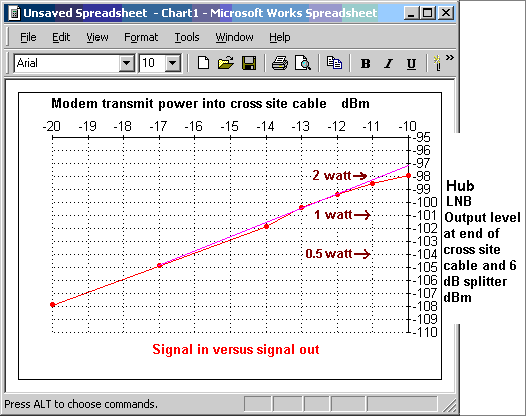Post by Eric Johnston on Jan 28th, 2008 at 11:48am
Be careful..
If the BUC has 55 dB gain and you put -20 dBm into it then output power should be +35 dBm or +5 dBW or 3.2 watts.
1 watt = +30 dBm or +0 dBW
2 watts = +33 dBm or +3 dBW
4 watts = +36 dBm or +6 dBW
8 watts = +39 dBm or +9 dBW
10 watts = +40 dBm or +10 dBW
Unless you have a very long cable, a modem level of -5 dBm is likely to overload the BUC and cause severe interference to return link services on adjacent frequencies. It will also degrade your own carrier as it will be distorted.
BUCs must be operated at or below their -1dB compression point, which is the rated power.
In other words don't try to transmit more than 2 watts with a 2 watt BUC.
Once the hub has control they should adjust for the correct level.
Ideally the hub should put the transmit into CW mode and increase the drive in 1 dB steps while measuring the output. Once the graphed line becomes non-linear and there is a 1 dB vertical gap between the projected straight line and the actual output curve, the BUC is at its 1 dB gain compression point. The drive level for the 1 dB gain compression point should be recorded for reference as a "never-to-exceed" value. ( opt file. max power )
This image shows how altering the modem tx power altered the receive level at the hub. Note that during the last three adjustments it goes non linear and at the final measurement the gain is 1 dB below what the straight line projects. This is the rated 2 watt output maximum at the -1dB compression point.
Cross pol measurement and adjustment should made if necessary. With modulation back on the Eb/No should be set to nominal, assuming clear sky conditions at the time.
It gives confidence if you then experimentally and temporarily reduce the power 4 dB (at Ku band) and check everything continues to work normally under faded conditions. This shows you have a decent rain margin. Reducing the power by 10 dB should make it fail. If such a reduction actually improves the service be alert to the possibility that the BUC might have been operating in grossly overloaded way.
Best regards, Eric.
If the BUC has 55 dB gain and you put -20 dBm into it then output power should be +35 dBm or +5 dBW or 3.2 watts.
1 watt = +30 dBm or +0 dBW
2 watts = +33 dBm or +3 dBW
4 watts = +36 dBm or +6 dBW
8 watts = +39 dBm or +9 dBW
10 watts = +40 dBm or +10 dBW
Unless you have a very long cable, a modem level of -5 dBm is likely to overload the BUC and cause severe interference to return link services on adjacent frequencies. It will also degrade your own carrier as it will be distorted.
BUCs must be operated at or below their -1dB compression point, which is the rated power.
In other words don't try to transmit more than 2 watts with a 2 watt BUC.
Once the hub has control they should adjust for the correct level.
Ideally the hub should put the transmit into CW mode and increase the drive in 1 dB steps while measuring the output. Once the graphed line becomes non-linear and there is a 1 dB vertical gap between the projected straight line and the actual output curve, the BUC is at its 1 dB gain compression point. The drive level for the 1 dB gain compression point should be recorded for reference as a "never-to-exceed" value. ( opt file. max power )
This image shows how altering the modem tx power altered the receive level at the hub. Note that during the last three adjustments it goes non linear and at the final measurement the gain is 1 dB below what the straight line projects. This is the rated 2 watt output maximum at the -1dB compression point.
Cross pol measurement and adjustment should made if necessary. With modulation back on the Eb/No should be set to nominal, assuming clear sky conditions at the time.
It gives confidence if you then experimentally and temporarily reduce the power 4 dB (at Ku band) and check everything continues to work normally under faded conditions. This shows you have a decent rain margin. Reducing the power by 10 dB should make it fail. If such a reduction actually improves the service be alert to the possibility that the BUC might have been operating in grossly overloaded way.
Best regards, Eric.
